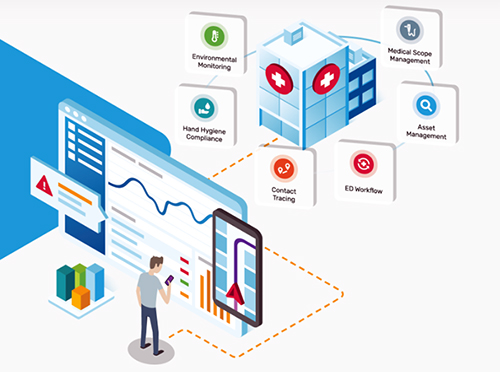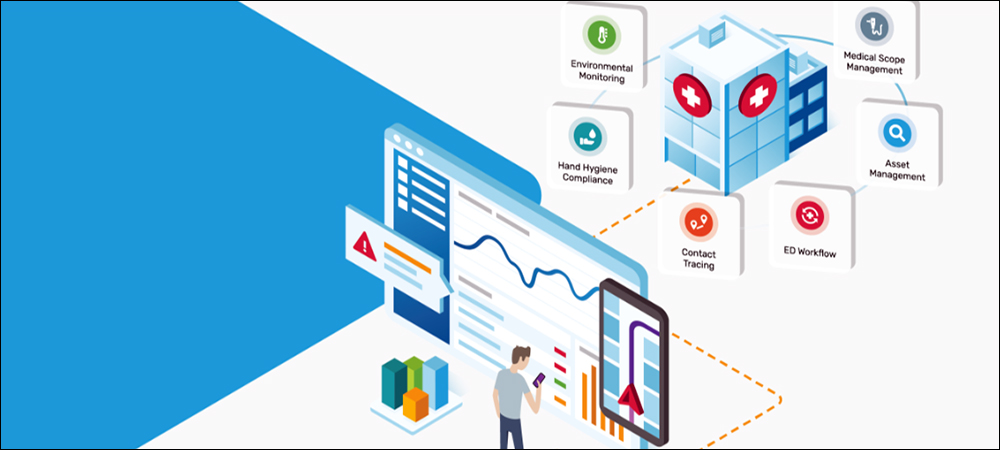Real-time locating system (RTLS) technology company CenTrak is expanding its healthcare offerings through acquisitions, and by broadening its product and solution portfolio. The company has begun offering an end-to-end solution that hospitals can employ from a single source, catered to meet their unique challenges.
The expanded offering is timed to aid hospitals challenged with pandemic-era issues, says Dave Minning, CenTrak’s president and CEO, while the long-term goal is to offer a way for medical facilities to better achieve a return on their RTLS investments. The company is leveraging several acquisitions to provide its solution, including the purchase of Internet of Things (IoT) company Elpas in 2018 (see CenTrak Acquires Elpas Solutions to Bolster IoT Security Offerings), Cetani a year later, and wayfinding solutions company Spreo in February 2020.

Hospitals can deploy CenTrak’s end-to-end solution from a single source, catered to meet their unique challenges.
Elpas, formerly a safety and security subsidiary of Johnson Controls, offered Bluetooth Low Energy (BLE) and low-frequency (LF) RFID apps to provide visibility into the locations of individuals such as residents at senior living environments for safety and security solutions. CenTrak now builds this functionality into its own offerings. Cetani provides CenTrak with a software platform that enables data from multiple sensor-based technologies to be captured, managed and integrated with healthcare-specific systems. The software manages data collected from RTLS, RFID and other types of sensors. Spreo offered a mobile wayfinding app that lets hospitals help visitors navigate their way around large facilities.
CenTrak’s Gen2IR technology is being employed by healthcare technology providers that offer their own software platforms using CenTrak’s tags, transmitting to Gen2IR beacons, that can determine a tag’s location and forward that data to the software. For more information on this, see the following stories: RTLS Helps Hospital Cut Surgical Turnaround Time by 10 Percent, Hospital Builds Intelligence One RTLS Step at a Time and Medical Clinic Cuts Patient Wait Times by 75 Percent.
The company intends to continue offering its RTLS hardware for software providers and systems integrators, says Minning, who joined CenTrak four months ago. He likens the Gen2IR products to utilities that provide a backbone on which intelligence can be built by third-party companies. “One of the reasons we’ve been successful up to this point is that we’ve been software-agnostic,” he states. “We have a very open architecture.” Hospitals can select such applications as nurse call integration, patient-flow or asset-management systems, he says, while partners can provide solutions with CenTrak’s technology.
Now, CenTrak serves hospitals as a single-source provider. Minning notes that RTLS for healthcare is a known entity, adding, “It has become something that hospitals have, or are looking at. It’s becoming fairly mainstream.” However, the company has found that many RTLS deployments fail to achieve the return on investment the hospital had expected. A disappointing ROI can result from a solution that does not meet the specific needs of a hospital, CenTrak explains, as well as from a lack of ongoing support by the technology provider.
For instance, Minning says, once the technology is installed, a commitment must be made to use that solution as it was intended. Hospitals need to train personnel to use the technology, and at times there can be conflicting priorities, which can lead to workers failing to use the system. For instance, CenTrak intends to offer a new program known as CenTrak Engage, which will be focused on providing clinical consulting and managed services. “We’ve been technology-focused and relied on partners and hospitals to implement the people and processes,” Minning says. “Now, we are going to be supportive with the people and the process.”
In the meantime, the demand for an ROI may be greater as hospitals navigate the COVID-19 pandemic, since the virus outbreak has disrupted elective procedures and thus reduced revenues. “I think hospitals expect more from their investments,” Minning says, and with the challenges brought on by the pandemic, he expects that to become more intense. Challenges have been multifold for RTLS deployments during the pandemic, he adds, beginning with the basic problem of coming onsite to install the technology during a need for social distancing or quarantines. Even as quarantines have eased, many hospitals have been cautious about bringing additional people onsite.

Dave Minning
What’s more, budgets are tight as hospitals decide where they can make investments. Despite such challenges, the pressure of treating an influx of patients suffering from the coronavirus has exposed how well existing asset-management solutions are working. The pandemic has given some hospitals the opportunity to assess whether their workers can access the tools and equipment they need to treat patients. If an RTLS solution is working properly, a hospital can view the location of equipment within its premises, confirm that it has been maintained, cleaned and sanitized, and receive alerts for events such as multiple equipment items requiring cleaning.
Technology provides another potential benefit during the pandemic, Minning adds: contact tracing functionality, since location data can be captured regarding patients or personnel based on badges, pendants or wristbands (transmitted to beacons) as those individuals move around a facility. Hospitals are seeking to use the RTLS data for contact tracing, Minning says, and he expects the value to last long after the COVID-19 pandemic has ended. “This may not be the last time we see a pandemic,” he notes, and regulations or best practices may be imposed on and by a hospital for any infectious diseases.
Nursing homes face similar challenges. CenTrak released its TruView system for the senior-care market in late 2019 (see RTLS Provides Wander Management at Senior-Living Facility). The system is intended to provide security and wander management at independent retirement, assisted living, skilled nursing and memory care sites. The solution includes a wearable RTLS device so that managers can view both real-time and historic location data regarding individuals in a building or on a campus. With the technology, such facilities can also conduct contact tracing in the event of a resident or worker testing positive for COVID-19.
In addition, Minning says, CenTrak provides hand-hygiene features as part of its product offering. “Our vision is growth,” he states, “and we’re going to do that largely by the acquisition of new technologies that could enter us into new modalities of locating.” The company is currently looking into UWB, BLE and other IoT technologies. “On the software side, we will look at companies with best-of-breed applications or data-analytics capabilities we don’t have.” The company is also looking for new markets in senior care and other areas, he reports.


